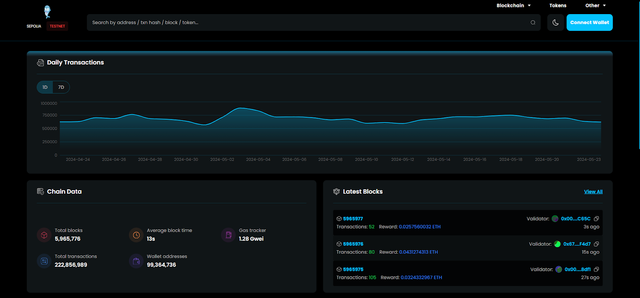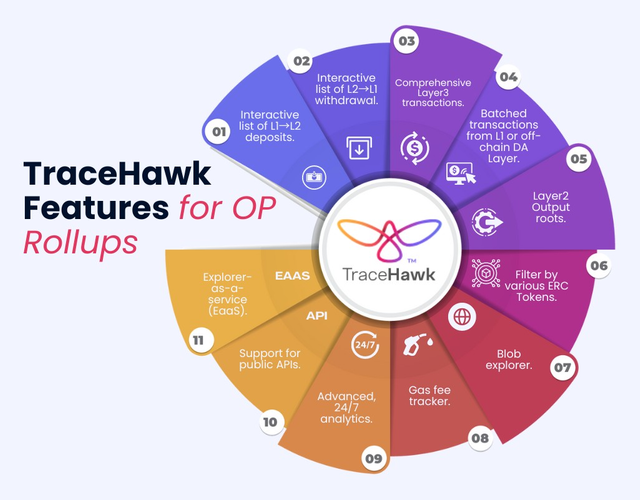
Transparency and accessibility are the most important aspects of any blockchain, and they have been equipped well with today’s advanced block explorers. However, the need for explorers in rollups can differ. That’s because blockchain rollups are based on distinct scaling concepts when compared to Layer2 solutions although both have the same end goal of boosting blockchain scalability.
Considering this, TraceHawk is stepping up to redefine users’ experience of interacting with their Layer2 or Layer3 rollup chains. Through this article, we will shed light on TraceHawk’s specific functionalities and features designed to offer a reliable block explorer for OP Stack rollups.
TraceHawk’s quick glance
TraceHawk is an open-source, fully customisable block explorer for developers, users, and researchers to explore and scrutinize all sorts of blockchain-level transactions. Designed as a multi-ecosystem explorer, TraceHawk supports all the custom L1/L2/L3 chains, rollups and appchains based on leading frameworks such as OP Stack, Arbitrum Orbit, Polygon CDK, Zk Sync Era, Cosmos SDK, Substrate, and more. Highly interactive UX, blazing-fast response, broad options for branding, powerful APIs and multiple token support are some of the main features of TraceHawk explorer. However, TraceHawk can be easily customized to offer all the features specific to your project and provide all the transactional and other network-specific data once they are finalized. Want to dive deeper into TraceHawk? Get end-to-end information from the blog linked below:
TraceHawk: A Full-suite Multi-ecosystem Block Explorer

The need for an OP Stack Rollups-specific block explorer
Due to multiple rollups featuring their unique architecture/working mechanism, users may face challenges while navigating, retrieving, and validating specific data using general-purpose explorers as they are usually optimised for main chains. Speaking about OP Stack rollups, users can experience challenges to fetch Layer2 transactions or navigate blobs or there can be fragmentation in output roots data. An OP stack rollups-specific explorer like TraceHawk can remove all these pitfalls and is also specialized to support OP Stack rollup chains, allowing users to get in-depth insights from OP Stack networks such as Layer2 transactions, deposits, bathed transactions, output roots, verified contracts, and other data related to the other operations taking place across the network.
Diving into TraceHawk’s OP Stack-specific offerings
As discussed, TraceHawk explorer is designed to support for all the leading rollup chains. Below are its main offerings for OP Stack rollups:

Interactive list of L1→L2 deposits:
As a rollup-optimized explorer, TraceHawk’s primary feature is to allow users to fetch a comprehensive and interactive list of all the deposits happening from Layer1 to Layer2 rollup. Within one click, you will see the entire data on the explorer’s interface. Likewise, you can get the deposit list of Layer2 OP stack rollups.
Interactive list of L2→L1 withdrawal:
TraceHawk explorer provides you a comprehensive list of details for Layer2 —>Layer1 withdrawal. Data for this interface keeps updating in real-time, showing the updated insights. Further, you can dive deeper into the withdrawal data to get information such as withdrawal status, method, contract details, transaction fee, etc.
Comprehensive Layer3 transactions:
If your OP Stack rollup is built upon Optimism (or any other layer2), instead of Layer1, and it uses Layer3 for off-chain transaction processing, then TraceHawk will allow you to effortless navigate the L3 ecosystem and retrieve the comprehensive list of transactions through its OP Stack explorer.
Batched transactions from L1 or off-chain DA Layer:
OP Stack rollups publish compressed transaction batches to Layer1 to ensure data integrity and 100% availability. Using TraceHawk, you can get a list of all these transaction batches that are posted on Layer1 through a specific sequencer. Also, if your OP Stack chain has incorporated an off-chain DA layer like Celestia, Eigen DA, or NEAR DA– the TraceHawk explorer will also fetch data from that alternative DA and provide it through the explorer.
Layer2 Output roots:
Knowing that output roots play a vital role in maintaining OP rollups’ state, TraceHawk allows you to get a list of Layer2 blocks’ output roots out of the vast indexed database.
Filter by various ERC Tokens:
Apart from addresses, hash, and blocks– TraceHawk explorer allows for the filtering of various tokens, for example, Optimism (OP) in the case of OP Stack. Through this option, you can get all the essential token data, such as real-time token price, holders, contract, market cap, and total supply within the explorer interface, eliminating the need to exit. Similar to this, you can retrieve data about any ERC20, ERC-721, ERC-1155, and all the other relevant ERC tokens.
Blob explorer:
Interact with the comprehensive blobs-carrying transaction details and navigate through blob’s content seamlessly on TraceHawk. The explorer allows you to get blob data across various formats, assisting you to have a firm understanding of Blobs’ significance and its structure within the whole Optimism ecosystem.
Gas fee tracker:
TraceHawk has the gas tracker feature to help users explore real-time OP Mainnet gas prices, historical gas fee trends, and details of gas utilized by various contracts. Further, the gas tracker accommodates for monitoring network’s gas expenses, validating the usage, and seamless management of all the gas-related processes.
Advanced, 24/7 analytics:
Access a wealth of on-chain insights into Optimism network’s operations. TraceHawk’s analytics feature presents all sorts of information in an easy to understand manner via graphical charts & metrics to provide a detailed view of OP stack rollups, blocks, blobs, and transactions happening all across the ecosystem.
Explorer-as–service (EaaS) support:
To enable stand-out user experience in your OP Stack chains, a highly performant and scalable block explorer plays a vital role. That’s why TraceHawk offers a state-of-the-art block explorer for OP Stack rollups that are designed to serve as a fully-hosted and fully-managed solution, eliminating the heavy lifting on your end.
Powerful public APIs:
To provide you highly-specific data and make development a breeze, TraceHawk offers secure and optimised public APIs that allow you to quickly fetch a range of data, such as blockchain data, wallet data, token details, NFT data, as well as market insights– all through just single lines of codes.
Conclusion
TraceHawk’s block explorer for OP Stack rollups is now available for web3 projects to use and unlock a whole new experience of exploring the L2 and L3 rollup ecosystems which foster a more transparent and inclusive environment. Note that TraceHawk is not limited to the features and benefits that we discussed in this blog post. Rather, it has endless customization possibilities to match your use case requirement. Hence, if you are building an OP Stack rollup or any other rollup and you need a custom blockchain explorer, feel free to connect with us. Our experts will be happy to handle your queries and streamline your project.